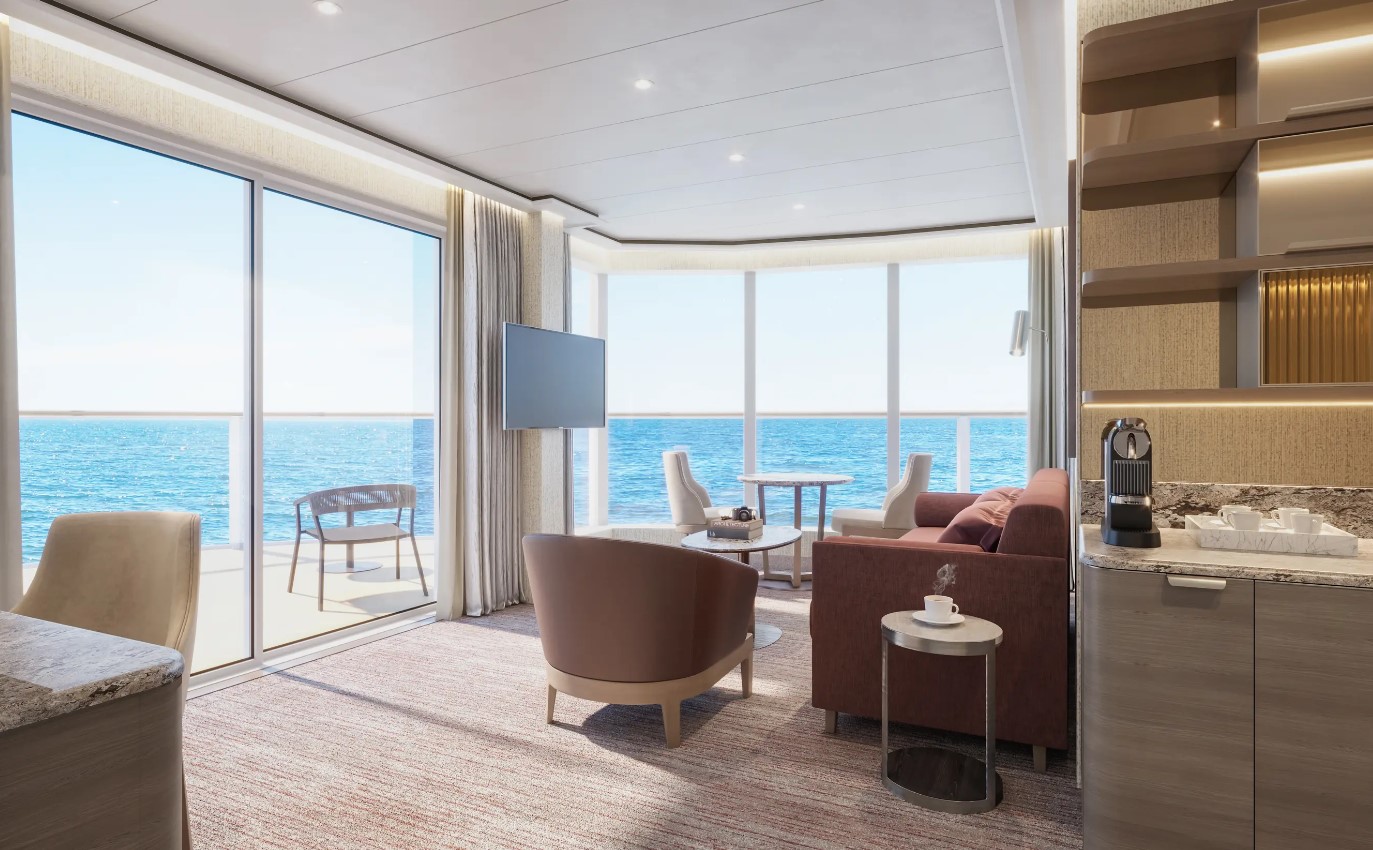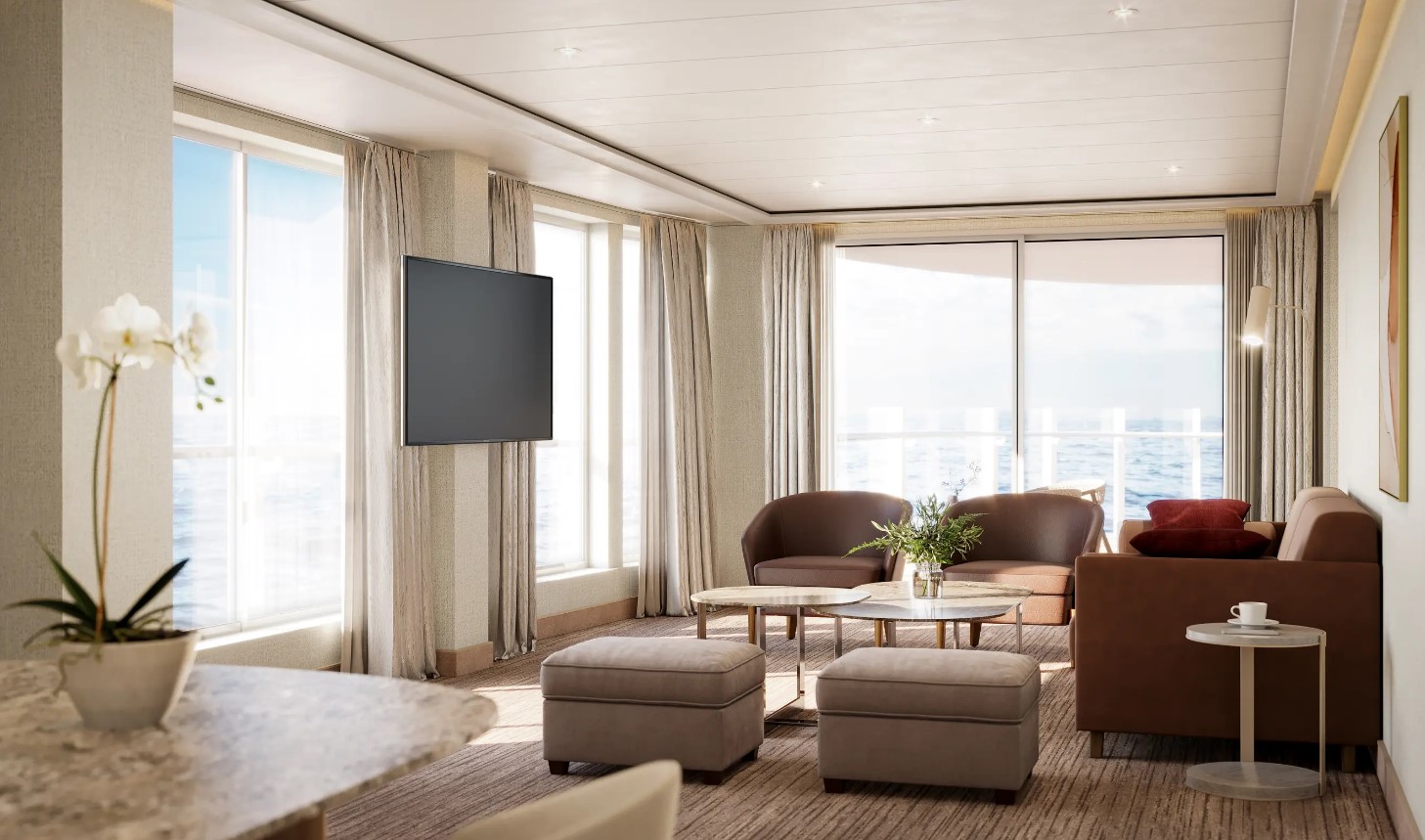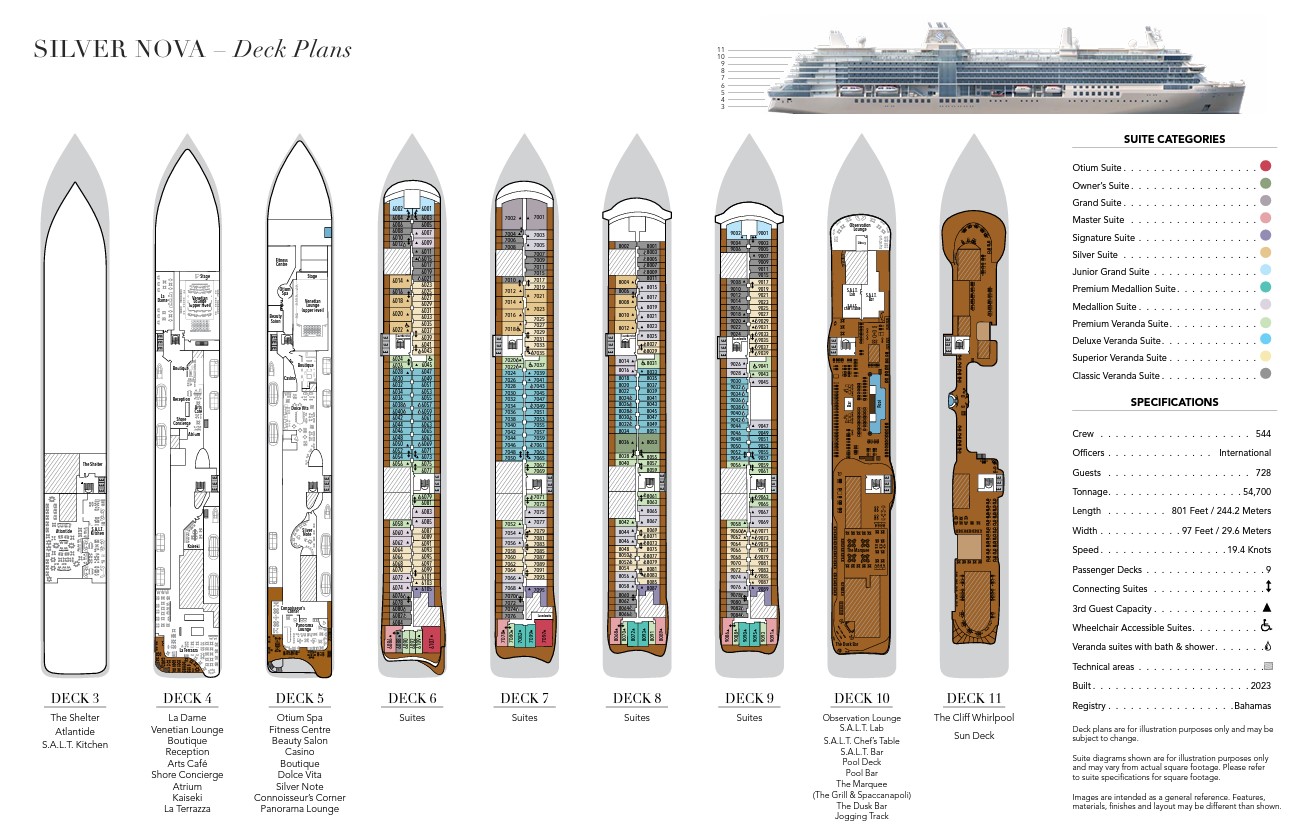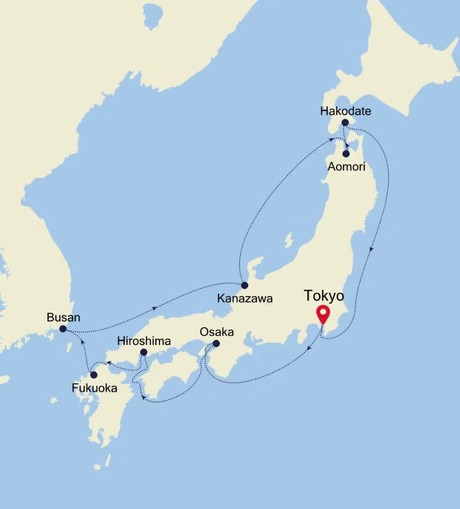17 Days Luxury Japan Cruise - Tokyo to Tokyo
With as many restaurants run by robots as ancient temples, there is no denying that Japan is a country of contradictions. So how should we begin to describe this indescribable place? Try starting with a day in Osaka. Contemplate the solemn history of Hiroshima before weaving your way into South Korea for Busan’s temples by the sea. Sail back to Japan for an overnight in Kanazawa, plus a long stay in Aomori. Last but definitely not least is Hakodate, home to the Onuma National Park and its abundant wildlife.
Highlights
• Experience Osaka’s futuristic energy and Hiroshima’s solemn history.
• Enjoy an overnight stay in Kanazawa, home to the famous Kenroku-en Garden and Geisha districts.
• Explore Hokkaido’s natural beauty in Hakodate and Aomori before returning to Tokyo.
Pre Cruise Benefits
Private Executive Transfers
International flights - Economy class
or Business Class upgrade
Airport transfers
Hotel
Dense and delightful, there’s nowhere else like Japan’s kinetic capital - a city where ancient traditions blend seamlessly with a relentless pursuit for the future’s sharpest edge. See the city from above, as elevators rocket you up to towering viewing platforms, from which you can survey a vast urban ocean, interspersed with sky-scraping needles. Look out as far as the distant loom of Mount Fuji’s cone on clear days. Futuristic – second-accurate - transport seamlessly links Tokyo’s 14 districts, while the glow of flashing advertisement boards, clanks of arcade machines, and waves of humanity flowing along its streets, adds to the sense of mesmerising, dizzying and glorious sensory overload. One of Tokyo’s most iconic sights, don’t miss the flood of people scrambling to cross Shibuya’s famous intersection. Join the choreographed dance, as crowds of briefcase-carrying commuters are given the green light to cross at the same time – bathed in the light of massive neon advertisements. The culture is immensely rich and deep, with 7th-century, lantern-decorated temples, stunning palaces and tranquil scarlet shrines waiting below cloaks of incense and nestling between soaring skyscrapers. Restaurants serve up precisely prepared sushi, and wafer-thin seafood slivers, offering a unique taste of the country’s refined cuisine. Settle into traditional teahouses, to witness intricate ceremonies, or join the locals as they fill out karaoke bars to sing the night away. In the spring, cherry blossom paints a delicate pink sheen over the city’s innumerable parks and gardens.
Days at sea are the perfect opportunity to relax, unwind and catch up with what you’ve been meaning to do. So whether that is going to the gym, visiting the spa, whale watching, catching up on your reading or simply topping up your tan, these blue sea days are the perfect balance to busy days spent exploring shore side.
Japan’s third-biggest city has thrown off its shackles and stepped out of the shadows to light up the sky with glaring neon signs and a larger than life outlook. Giant octopuses cling to buildings and bustling restaurants pack in the crowds in this great and garish place, which is Japan at its most friendly, extroverted and flavourful. So dive in headfirst to experience an all-out sensory assault of delicious food, shopping cathedrals and glittering temples. Dotombori Bridge bathes in the multicoloured, jewel-like lights of signage-plastered buildings, and the neon lights dance on the canal's waters below. Osaka is known as the nation's kitchen, and the Kuromon Ichiba Market has served as the city's spot to tuck in for almost 200 years. Full of street food stalls - try pufferfish, savoury Okonomiyaki pancakes, or ginger and onion flavoured octopus, among the endless feast of exotic flavours. Osaka Castle is another of the city’s landmarks, built in the 16th century by Toyotomi Hideyoshi. A modern museum now waits inside, where you can learn about the country's history, and why this castle is a symbol of Japanese unity. Be sure to take the elevator up to the observation deck for a panoramic view of Osaka's spread. A colourful park encloses the castle and blooms with an ocean of pale pink cherry blossom during the season - the elegant black tiers rising from the pink haze below is one of Osaka's most alluring visions. Kyoto’s peaceful cultural treasures and temples are also just a short jaunt away on Japan’s sleek trains, should you wish to explore further afield.
Days at sea are the perfect opportunity to relax, unwind and catch up with what you’ve been meaning to do. So whether that is going to the gym, visiting the spa, whale watching, catching up on your reading or simply topping up your tan, these blue sea days are the perfect balance to busy days spent exploring shore side.
History buffs will want to write home Hiroshima. Despite being devastated in 1945, this Japanese city is known to all for its commitment peace – its ruin on the 6th August 1945 led to the end of the war and today, the Peace Memorial (a UNESCO World Heritage Site), is a constant reminder of the destruction that war brings. A walk in the leafy boulevards of Peace Memorial Park brings quiet contemplation. The Flames of Peace – set in the park’s central feature pond – burn brightly and will continue to do so until all the nuclear bombs in the world have been destroyed. There are many other inspiring messages of hope around the city too; the Childrens’ Peace Monument just north of the park is a homage to little Sadako Sasaki, who was just two in 1945. When she developed leukaemia in 1956, she believed that if she folded 1,000 paper cranes – a symbol of longevity and happiness in Japan – she would recover. Sadly, she died before she finished her task but her classmates finished the rest. If you are lucky enough to visit during the unpredictable and short-lived Sakura (cherry blossom) season, then the extraordinary sight of the delicate pink blossom floating across the water to the red gate means you can consider yourself one of the luckiest people on the planet.
Sail through the eye of a needle while cutting through this fabled passage of Japanese water, separating Kyushu from the country’s largest island, Honshu. The two islands brush up against each other here, parted only by the scenic S-bend of water. Sail below the mighty span of sweeping suspension bridges like Kanmonkyo Bridge, while transiting this hugely important and strategic thread, which links the Sea of Japan with the Inland Sea. The natural bottleneck here has instigated historic battles on and around these waters over the centuries, tilting the history of Japan and the region back and forth. Learn of rich maritime heritage and historic agreements - like the Treaty of Shimonoseki, which was inked on these shores. Nowadays, the passage is a peaceful, pleasant affair to cruise through. Ferries and pleasure boats criss-cross the two shorelines, where a mere 700 metres of blue water separates the islands at their closest point, and tunnels - including a pedestrian route - seamlessly connect the cities of Shimonoseki and Kitakyushu. There’s always something going on throughout the year, whether it’s Kitakyushu city blooming with renowned cherry blossoms in spring, or the strait’s waters lighting up during the firework festival - when each island celebrates and collaborates in a vibrant dual display. Equal parts scenic and storied, this is one of Japan’s most beautiful and intriguing stretches of water and a fascinating passage through history.
Boasting Japan’s heady cocktail of hot springs, gourmet food, abundant nature and spiritual history, Kyushu Island has all the advantages of the mainland, while enjoying its own identity. The island is the third largest of Japan’s five island provinces and prides itself on having everything you could expect from the Land of the Rising Sun. The capital of the island, Fukuoka, is Japan in a bite sized morsel. As one of the country’s most strategic ports – it is closer to Seoul than Tokyo – the city has enjoyed a somewhat prestigious status over the years, including two unsuccessful Mongol invasion attempts in the 13th century. Some scholars suggest that the city is also the first place the Imperial Family set foot, although actual proof of this is scarce. What is certain however is that it was once the home of the samurai, with many samurai related spots found all over the city. A trip to the Kyushu National Museum will allow budding actors to try on traditional costumes and channel their inner feudal lord, while local shrines, tranquil Zen gardens and castle ruins all offer a chance to relive the city’s glory days. The city itself is made up of two smaller towns (Fukuoka and Hakata), and despite unification in 1889, Hakata is still considered the centre. A 2018 survey ranked the city number 22 on “the world’s most liveable cities” list, due to its excellent shopping, outstanding food, excellent transport links, good museums, “feeling of openeness”, green spaces and friendly, safe, environment.
"A tapestry of kaleidoscopic colours, intense seafood flavours, and urban beach bliss, Busan rolls across a glorious natural setting on the Korean Peninsula's south-east. One of the largest and busiest ports in the world, 3.5 million people call South Korea's second city home, and the amiable locals help to lend the city its quirky, offbeat outlook. A spacious, playful and cosmopolitan place, Busan is a lively, liveable city, cradled by lush mountains and endless ocean scenery. Haedong Yonggung Temple nestles on a dramatic cliffside, just above the crumbling rocks and crashing waves of the East Sea. Dating back to 1376, the temple's multi-storey pagoda is adorned with lions - each representing a different emotion. Elsewhere, lanterns glitter in the night sky around Mount Geumjeongsan, freshly released from the beautiful Beomeosa Temple, which was established in AD 678. The hillside shantytown of Gamcheon Culture Village has completed an improbable transformation, blossoming from a sea of makeshift homes for Korean war refugees, into a colourful explosion of creativity and curiosity. Local artists have been let loose to create interactive installations, and the entire area is now an expansive canvas for expression. Lose yourself among vibrant alleyways of flamingo-pink, lemon-yellow and baby-blue painted facades in this unique area. Sample bibimbap, fiery-hot beef and rice, from street food vendors, before relaxing on one of South Korea's best beaches - Haeundae's banana bend of sand. Metallic skyscrapers offer an unusual backdrop to this pristine expanse of golden powder and are mirrored by elaborate sandcastles and sculptures during the annual sand festival - when spontaneous water fights and firework displays also take place. Gwangalli beach is another urban option, laying out spectacular views of the reaching Gwangan Bridge - the country's second largest bridge. At night, 16,000 bulbs bathe this engineering marvel in colour."
Days at sea are the perfect opportunity to relax, unwind and catch up with what you’ve been meaning to do. So whether that is going to the gym, visiting the spa, whale watching, catching up on your reading or simply topping up your tan, these blue sea days are the perfect balance to busy days spent exploring shore side.
The capital of the Ishikawa Prefecture, Kanazawa once rivalled Kyoto and Edo (Tokyo) as a town rich in cultural achievements. Kanazawa escaped destruction during World War II and accordingly has been able to preserve many of the old districts in good shape. The city is famous because of Kenrokuen. Located next to Kanazawa Castle, Kenrokuen is classified as “One of the Three Gardens of Japan”. The garden has an artificial pond, and hills and houses are dotted within the 11.4 hectares. It has Japan’s oldest fountain using natural water pressure and a tea-house dating back to 1774. Close by is the Higashi Chaya Gai Geisha District, designated a National Cultural Asset and the biggest of the Geisha districts of Kanazawa. Some of the houses not only retain the original structure, but still are used as Geisha houses. Some of the streets have traditional shops creating a nostalgic atmosphere. Kanazawa is also known for its lacquer ware, Kutani-style pottery, gold-leaf workmanship and delicately painted silk kimonos.
Days at sea are the perfect opportunity to relax, unwind and catch up with what you’ve been meaning to do. So whether that is going to the gym, visiting the spa, whale watching, catching up on your reading or simply topping up your tan, these blue sea days are the perfect balance to busy days spent exploring shore side.
From fiery festivals to spectacular mountain scenery, soaring temples to castles surrounded by cherry blossom blooms, Aomori is one of Japan’s most enchanting destinations. Framed by dark peaks clad with dense forestry, the city enjoys a picturesque location on Japan’s main island Honshu. While there are gorgeous pink tinted parks, tiered castles and towering Buddha statues to explore, the Aomori Prefecture’s capital is perhaps best known for the summer festival of fire that lights it up each year. Lavish illuminated floats fill the streets during Nebuta Matsuri festival, as dancing locals wave flickering lanterns through the night sky - and drummers pound out pulsating rhythms. Nebuta Matsuri has a euphoric and energetic atmosphere which makes it stand out as an unmissable experience compared with some of Japan’s more restrained festivals. At other times of the year, places like the stunning Hirosaki Castle bloom with rose-pink cherry blossom, as spring’s sunshine clears away winter’s plentiful snowfall. The castle’s moat, glowing with the pale hue of fallen blossom, is a truly mesmerising sight to behold. Don’t worry if you’re too late though, you might be able to catch the pink-flush of the apple blossom - which comes slightly later. Extraordinary prehistoric Jomon period history is waiting to be unearthed at the living archaeological site, Sannai-Maruyama Ruins. Or, the untouched wilderness of UNESCO World Heritage Site Shirakami Sanchi is within reach. This sprawling mass of beech trees covers a third of the Shirakami mountain range, and the dense forestry once blanketed the majority of northern Japan’s land. Visit to scratch the surface of this untamed landscape’s beauty and see sprawling waterfalls cascading down mountainsides, in a beautiful off-bounds landscape, where black bears roam freely.
Gaze down over Hakodate, from the heights of its namesake peak - Mount Hakodate - to see the city stretching out spectacularly, with back-to-back twin bays splitting the ocean. Hakodate port was one of the first to open Japan up to the world, and to international trade in 1859 - a fact reflected in the architecture, with its influences from the West and beyond. The port area is a redbrick wash of warehouses turned shopping malls, all observed by the onion domes of the city's Russian Orthodox church. Elsewhere, the star-shaped Goryokaku fortress glows with natural colours and a beautiful haze of cherry blossom during the season. Goryokaku Tower, which rises up beside it, offers a sweeping bird's eye view of the green fortress and mountain backdrop. Buses trundle up the 335-metre incline to the top of Mount Hakodate, but the best way to reach the views is to jump on the ropeway, which swings high above downtown's buildings, over a carpet of pine trees. Head up to the mountain's heights as sunset approaches. With darkness sweeping in, and the lights flickering to life, the panorama is one of Japan's most spectacular. Soak it all in, and look out to the horizon, dotted with the shimmering lights of ships hauling in harvests of the city's renowned squid. The plankton-rich waters attract a delicious variety of feasting sea life to Hakodate's coast, which is then plated up in the city's numerous, skilled restaurants. For an eye-opening, whirring morning, see the freshest produce being doled out at Hakodate Morning Market – amid a cacophony of noise and activity.
Days at sea are the perfect opportunity to relax, unwind and catch up with what you’ve been meaning to do. So whether that is going to the gym, visiting the spa, whale watching, catching up on your reading or simply topping up your tan, these blue sea days are the perfect balance to busy days spent exploring shore side.
Dense and delightful, there’s nowhere else like Japan’s kinetic capital - a city where ancient traditions blend seamlessly with a relentless pursuit for the future’s sharpest edge. See the city from above, as elevators rocket you up to towering viewing platforms, from which you can survey a vast urban ocean, interspersed with sky-scraping needles. Look out as far as the distant loom of Mount Fuji’s cone on clear days. Futuristic – second-accurate - transport seamlessly links Tokyo’s 14 districts, while the glow of flashing advertisement boards, clanks of arcade machines, and waves of humanity flowing along its streets, adds to the sense of mesmerising, dizzying and glorious sensory overload. One of Tokyo’s most iconic sights, don’t miss the flood of people scrambling to cross Shibuya’s famous intersection. Join the choreographed dance, as crowds of briefcase-carrying commuters are given the green light to cross at the same time – bathed in the light of massive neon advertisements. The culture is immensely rich and deep, with 7th-century, lantern-decorated temples, stunning palaces and tranquil scarlet shrines waiting below cloaks of incense and nestling between soaring skyscrapers. Restaurants serve up precisely prepared sushi, and wafer-thin seafood slivers, offering a unique taste of the country’s refined cuisine. Settle into traditional teahouses, to witness intricate ceremonies, or join the locals as they fill out karaoke bars to sing the night away. In the spring, cherry blossom paints a delicate pink sheen over the city’s innumerable parks and gardens.
Post Cruise Benefits
Airport transfers
International flights - Economy class
or Business Class upgrade
Private Executive Transfers
Itineraries are subject to change.
|
Book now |
Classic Veranda

Superior Veranda

Deluxe Veranda

Premium Veranda

Medallion

Premium Medallion

Junior Grand 1 Bedroom

Silver

Signature

Junior Grand 2 Bedroom

Master

Grand 1 Bedroom

Owner 1 Bedroom

Otium

Owner 2 Bedroom

|
Book now |
Classic Veranda

Superior Veranda

Deluxe Veranda

Premium Veranda

Medallion

Premium Medallion

Junior Grand 1 Bedroom

Silver

Signature

Master

Grand 1 Bedroom

Junior Grand 2 Bedroom

Owner 1 Bedroom

Otium

Owner 2 Bedroom

Vessel Type: Luxury Cruise
Length: 801 Feet / 244 2 Meters
Passenger Capacity: 728
Built: 2022/2023
Silver Nova is more than a new ship by Silversea, it is a Nova way of luxury travel.
Introducing Silver Nova – the twelfth ship to join our fleet. Our newest vessel will join us in summer 2023, and will be a home away from home for up to 728 guests. Silver Nova’s innovative asymmetrical design introduces the world like never before, offering an immersive destination experience to our guests. With a gross tonnage of 54,700 tons she will offer a space-to-guest ratio of 75 GRT-per-passenger becoming one of the most spacious cruise ships ever built. What’s more, Silver Nova will be our most environmentally friendly, and thanks to her groundbreaking technological solutions, she will propel Silversea into a new era of sustainable cruising. It’s the Nova way to travel.
S.A.L.T. Chef's Table – An intimate dining experience with a curated tasting menu highlighting regional flavors. Includes wine & cocktail pairing. Reservation fee: $180.
S.A.L.T. Kitchen – Destination-inspired menus featuring local flavors. The Terrain menu showcases the current port, while the Voyage menu offers highlights from the journey.
Atlantide – Classic fine dining with a sophisticated ambiance. Indulge in premium ingredients like caviar, lobster, and exquisite desserts.
La Terrazza – Authentic Italian cuisine with homemade pasta, antipasto, risotto, and bold regional wines. Enjoy stunning views from the outdoor terrace.
La Dame – French fine dining with curated tasting menus and wine pairings. Reservation fee: $160.
Kaiseki – Japanese culinary artistry with sake, whiskey, or tea pairings. Reservation fee: $80.
Silver Note – A lively venue with gourmet tapas, jazz, and soul music, perfect for a night of entertainment.
The Grill – Casual dining by day, transforming into the "Hot Rocks" BBQ experience at night, set in The Marquee.
Spaccanapoli – Thin, freshly made pizzas from Naples, served in an open-air setting at The Marquee.
The Pool Deck – Spacious sun deck with Silversea’s largest pool and an infinity-edge whirlpool for ultimate relaxation.
The Dusk Bar – Open-air sky bar offering panoramic views and destination-inspired cocktails.
The Marquee – A relaxed outdoor venue combining The Grill and Spaccanapoli for casual dining.
Arts Café – A cultural hub for light bites, fresh juices, coffee, and artistic inspiration.
S.A.L.T. Bar – Locally inspired cocktails reflecting each destination.
S.A.L.T. Lab – Hands-on culinary workshops exploring local food culture.
The Shelter – An elegant cocktail bar offering signature drinks in an intimate setting.
Dolce Vita – The ship’s social hub, featuring live piano music and expertly crafted cocktails.
Panorama Lounge – A versatile space for relaxing by day and live music or DJ sets at night.
Connoisseur’s Corner – A stylish cigar lounge with premium selections.
Observation Lounge – A peaceful retreat with panoramic sea views and an in-house library.
The Venetian Lounge – A grand theatre for live performances and film screenings.
Atrium – The heart of the ship, home to key services, The Shelter, and Arts Café, with stunning floor-to-ceiling windows.
Boutique – Luxury shopping at sea, featuring premium brands and exclusive collections.









Inclusions
Port-to-Port Service:
• Suite accommodations,
• Butler service in any suite,
• Unlimited Wi-Fi,
• Onboard meals and entertainment,
• 24-hour dining service,
• Beverages aboard ship including select wines,
• Champagnes, spirits, soft drinks, water, tea and coffee,
• Gratuities aboard ship (except spa).
______________
• Pre Cruise Benefits - Private Executive Transfers, International flights - Economy class or Business Class upgrade, Airport transfers, Hotel
• Post Cruise Benefits, Airport transfers, International flights - Economy class or Business Class upgrade, Private Executive Transfers
Exclusions
• International flights unless otherwise stated
• Passport and visa costs if applicable
• Travel insurance
• Optional shore excursions
• Spa and Salon Treatments
• Complete valet services, including laundry, pressing and dry cleaning, are available at an additional charge
Our Associates Include













